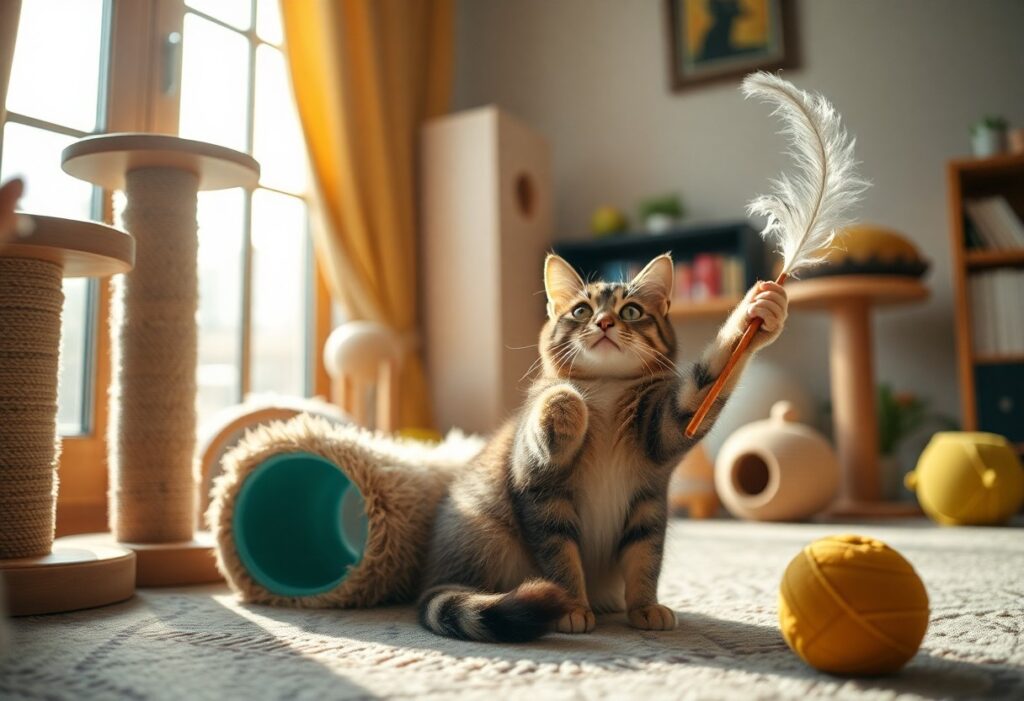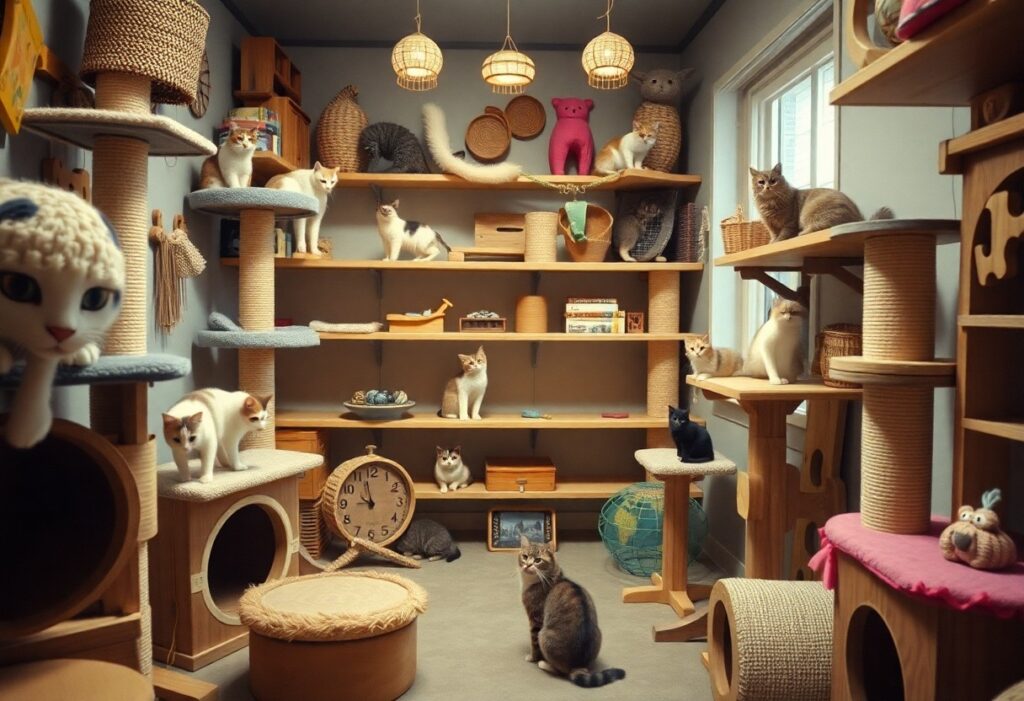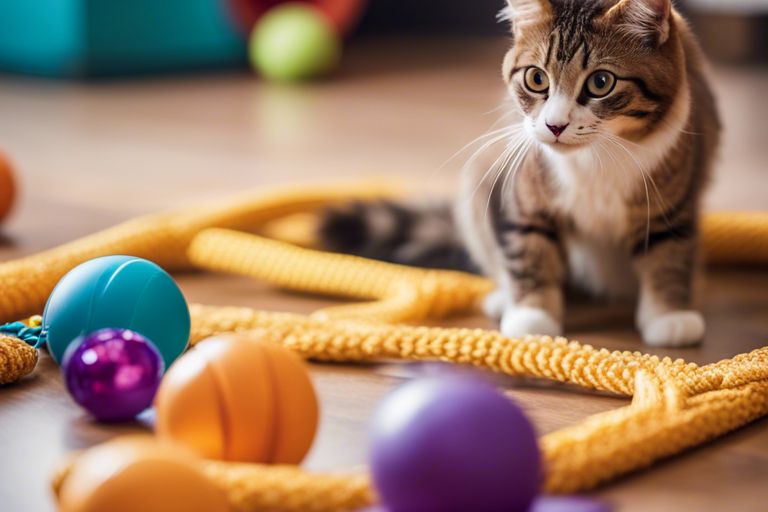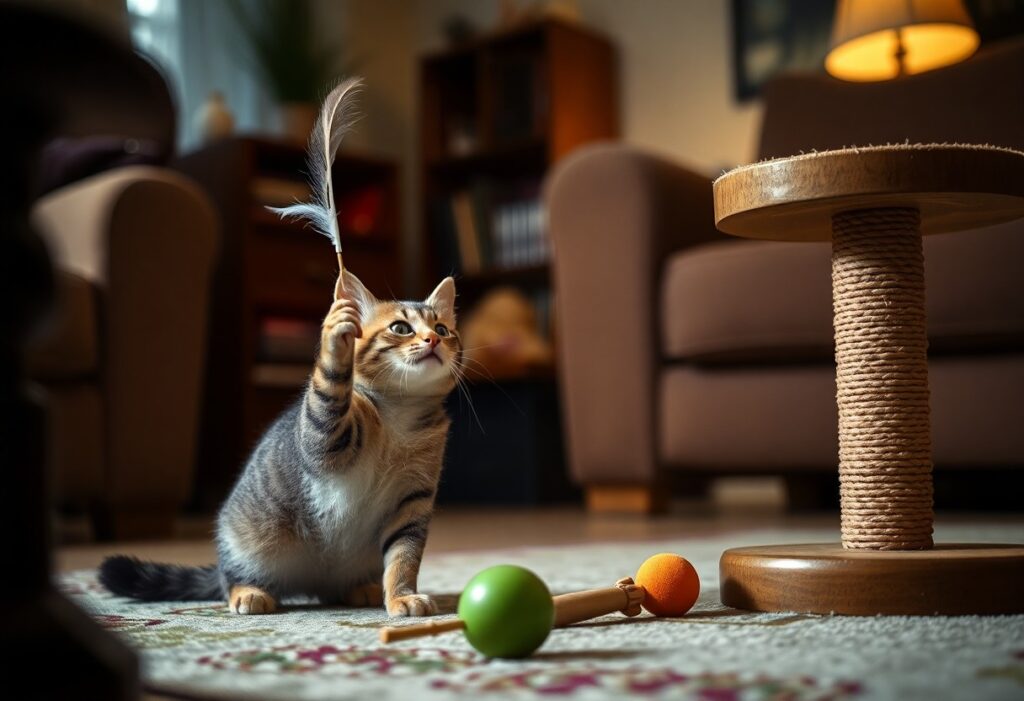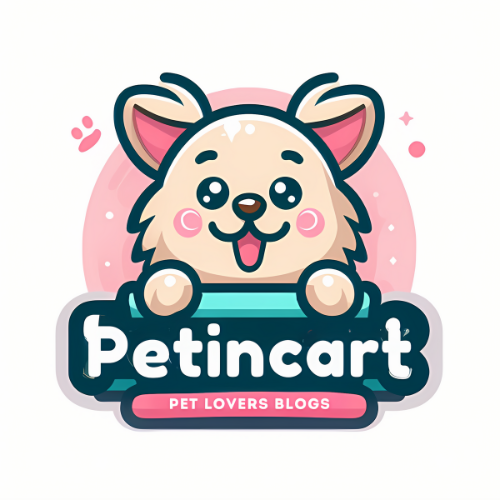It’s vital to recognize that indoor cats need stimulation to maintain their physical health and mental well-being. By providing your feline friend with engaging indoor diversions, you can unleash their playful nature and reduce unwanted behaviors. From interactive toys and puzzle feeders to climbing structures and laser pointers, there are plenty of opportunities to keep your cat active and entertained. This guide will explore effective strategies that will not only enhance your cat’s playtime but also strengthen the bond you share.
Key Takeaways:
- Provide a variety of toys, such as feather wands, laser pointers, and interactive games, to keep your cat engaged and stimulate their natural hunting instincts.
- Create an enriched environment with climbing structures, cozy hideaways, and scratching posts to encourage exploration and physical activity.
- Set aside dedicated playtime to foster bonding with your cat, ensuring they receive enough mental and physical stimulation throughout the day.
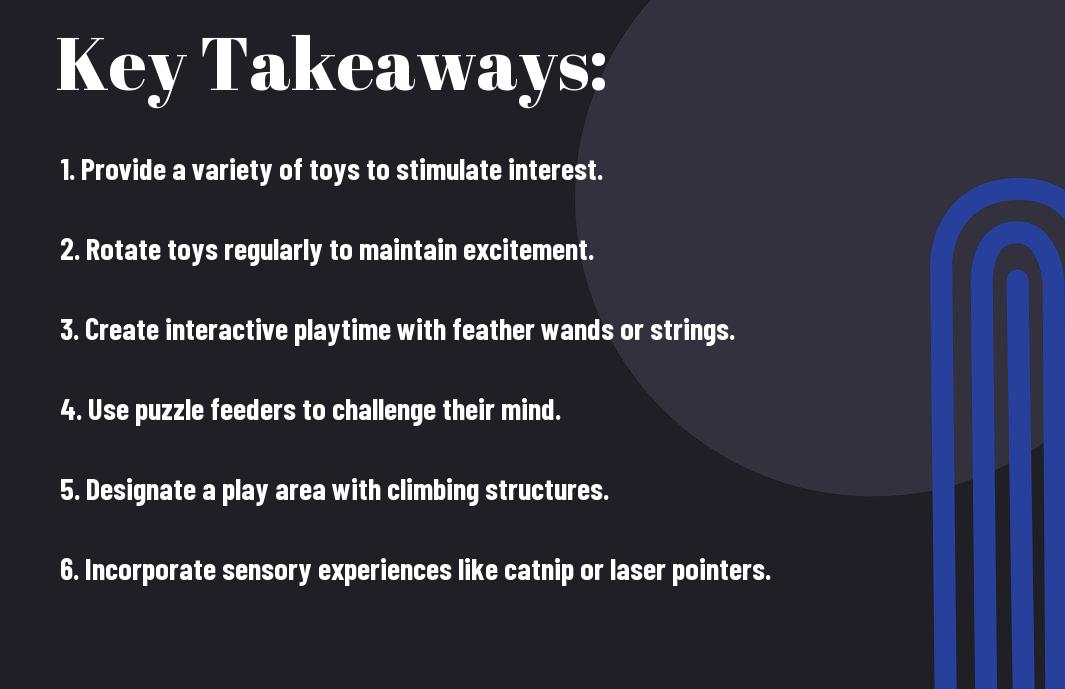
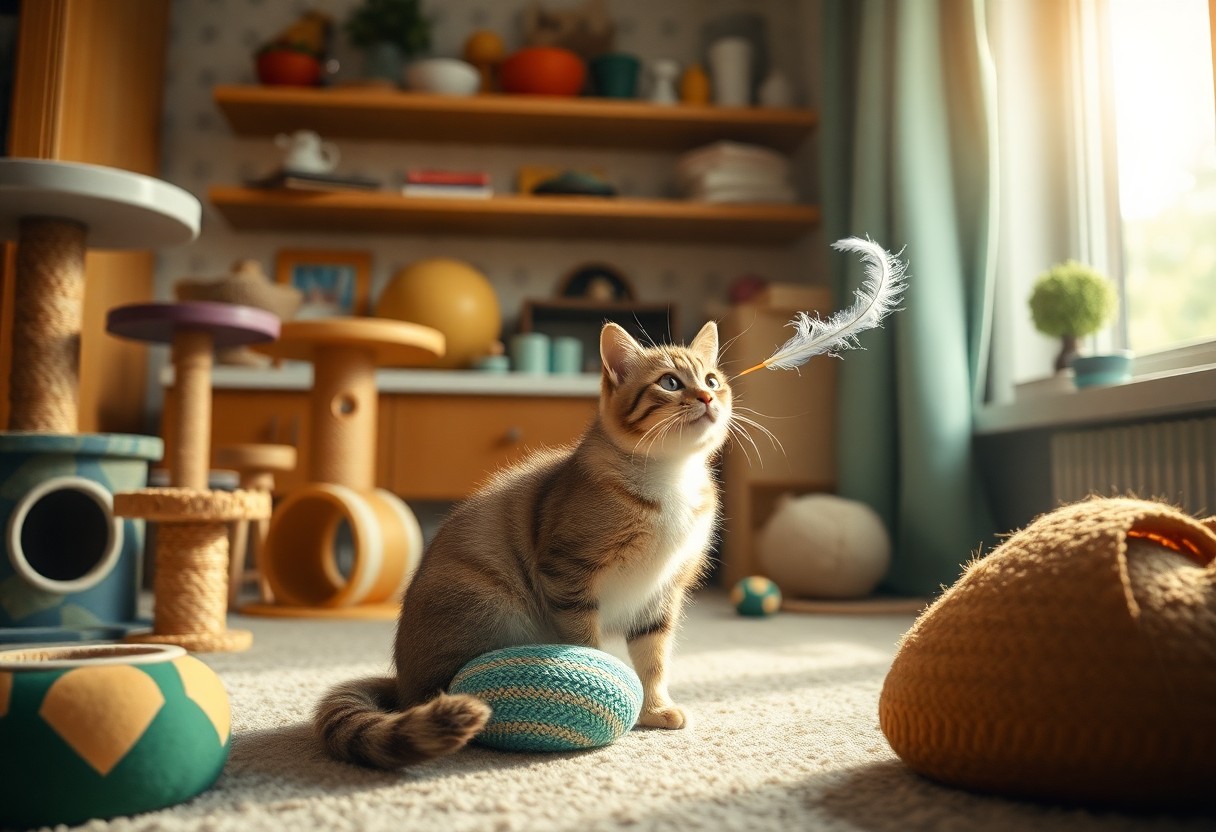
Understanding Your Cat’s Playful Instincts
For many cat owners, unlocking the playful side of their feline companions is a delightful yet challenging endeavor. It’s vital to recognize that cats are naturally inclined to engage in play as a means of honing their hunting skills, expressing energy, and combating boredom. Understanding these instincts will empower you to create a stimulating environment that encourages your cat to thrive and display its most playful behaviors.
Natural Behaviors in Cats
Above all else, play mimics the natural hunting behaviors of cats, allowing them to practice stalking, pouncing, and capturing prey. These actions fulfill their instinctual need for movement and mental engagement. By providing toys that replicate these experiences, you can enhance your cat’s quality of life and foster more meaningful interactions.
The Importance of Play
Your cat’s playtime is not just for entertainment; it serves a vital role in its overall health and wellbeing. Engaging in playtime helps reduce stress levels, combats obesity, and keeps your cat mentally stimulated. Without proper play opportunities, your feline can become bored, leading to unwanted behavior or even health issues. Thus, maintaining a consistent and varied play routine is vital for your cat’s happiness and longevity.
Consequently, taking the time to incorporate interactive toys, engaging games, and challenging activities will maximize the benefits of play for your cat. By investing in your cat’s playtime, you not only enhance their physical health but also strengthen the bond between you and your furry friend. A well-played cat is a happy cat, and this happiness translates to a more harmonious home environment for you both.
Creating an Engaging Indoor Environment
The key to unleashing your cat’s playful nature is to create an engaging indoor environment that stimulates their senses and encourages activity. Incorporating various elements like climbing structures, hiding spots, and interactive toys can turn your home into a playground that satisfies your feline’s natural instincts. Taking time to tailor this environment promotes mental and physical enrichment, keeping your cat happy and healthy.
Space Considerations
Behind every great play environment is an understanding of your available space. Consider the layout of your home, ensuring that there is enough room for climbing shelves, scratch posts, and safe play areas. Maximize vertical space, as cats love to explore heights, while also allowing for cozy nooks where they can retreat and observe their surroundings.
Essential Play Materials
Beside creating an inviting space, selecting the right materials is key to enticing your cat to play. Investing in a variety of toys—such as balls, feather wands, and interactive puzzles—stimulates your cat’s hunting instincts and keeps them engaged. Also, ensure that the toys are safe and suitable for your cat’s age and activity level. Regularly rotating these materials can maintain novelty, keeping your cat’s interest alive.
Engaging your cat’s playful side requires a thoughtful approach to play materials. You might choose high-quality interactive toys that challenge your cat’s problem-solving skills or simple household items like cardboard boxes for climbing and hiding. A mix of textured toys can appeal to your cat’s tactile senses, while sound-making toys can keep them intrigued. Always monitor their playtime for potential hazards, ensuring that your cat’s play environment remains safe and stimulating.
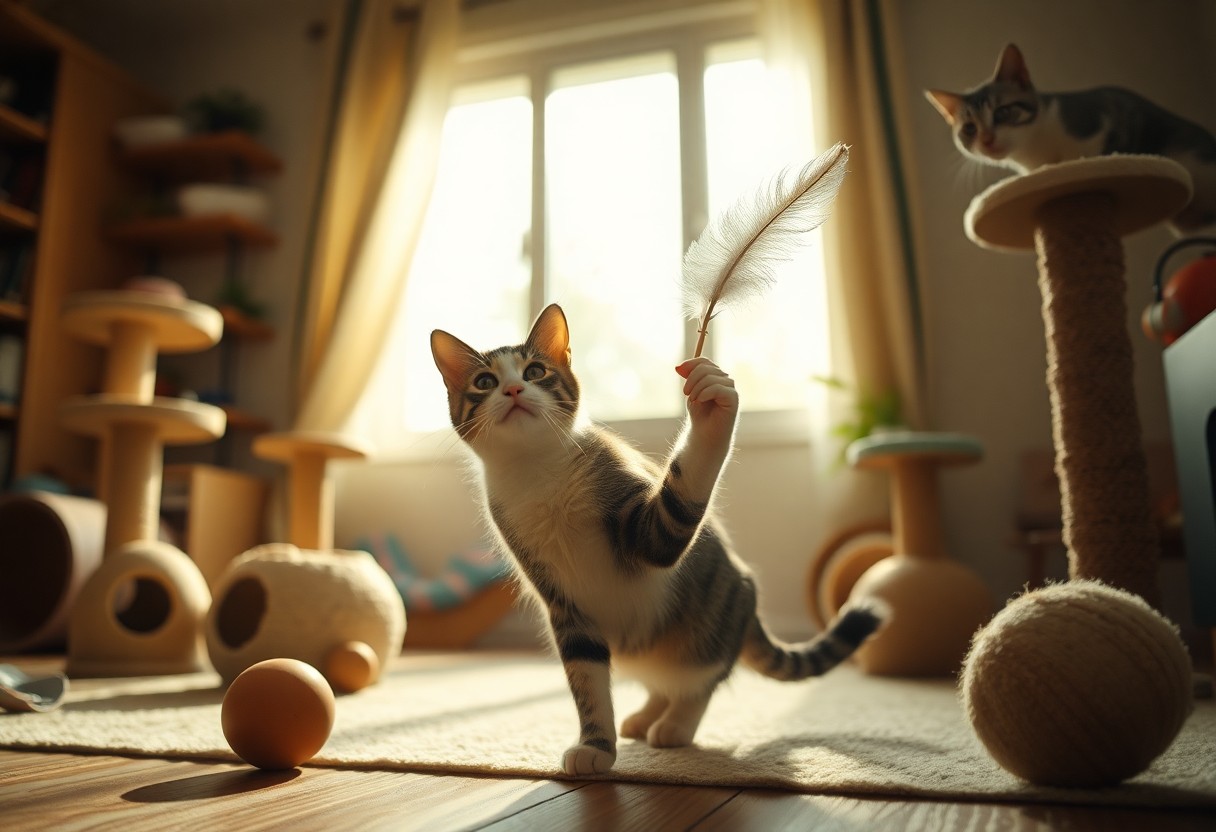
Interactive Toys for Cats
To unleash your cat’s playful nature, incorporating interactive toys can be a game-changer. These toys not only stimulate your cat’s mind but also promote physical activity, keeping them engaged and entertained. Whether it’s laser pointers, feather wands, or puzzle feeders, interactive toys cater to your cat’s natural instincts and provide endless fun.
Types of Interactive Toys
Before plunging into interactive toys, it’s vital to choose the right ones. Below is a breakdown of popular types:
| Laser Pointers | Encourages active chasing |
| Feather Wands | Engages hunting instincts |
| Puzzle Feeders | Makes mealtime a challenge |
| Interactive Balls | Promotes solo play |
| Motion-Activated Toys | Stimulates curiosity |
Assume that with a variety of options, you can keep your cat stimulated and content, leading to a more fulfilled indoor life.
Benefits of Using Them
Interactive toys are not just entertaining; they also provide various benefits that enhance your cat’s well-being.
This inclusion of interactive toys can significantly reduce behavioral issues stemming from boredom, such as scratching or aggression. They also enhance your pet’s physical health by encouraging regular exercise, which helps combat obesity. Additionally, these toys challenge your cat’s cognitive abilities, keeping their minds sharp and engaged. Ultimately, investing in interactive toys exemplifies your commitment to your cat’s health and happiness.
DIY Cat Enrichment Ideas
Keep your feline friend entertained and stimulated with DIY cat enrichment ideas. These activities not only engage your cat’s senses but also strengthen the bond between you and your pet. By incorporating simple homemade toys and activities, you can encourage independent play and promote physical and mental well-being.
Simple Crafts for Cat Play
Crafts can be a fun way to create unique toys for your cat. Try making a simple feather wand using a stick and some brightly colored feathers attached with string. This DIY project encourages active play and provides a great way for your cat to exercise while having fun.
Household Items as Toys
Among the various ways to enrich your cat’s playtime, using household items as toys can be highly effective. Look around your home for items like cardboard boxes, paper bags, or old socks to transform into engaging playthings. These materials often spark your cat’s curiosity and instinctual hunting behavior.
At home, common items can become exciting toys for your cat. For example, an empty cardboard box can serve as a cozy hideout or a perfect space for pouncing. Just be cautious with items like string or rubber bands, as these can pose choking hazards. Instead, consider crumpling up some paper to create a safe and noise-making ball for your cat to chase. Getting creative with everyday objects not only helps you save money but also ensures that playful engagement is always within reach.
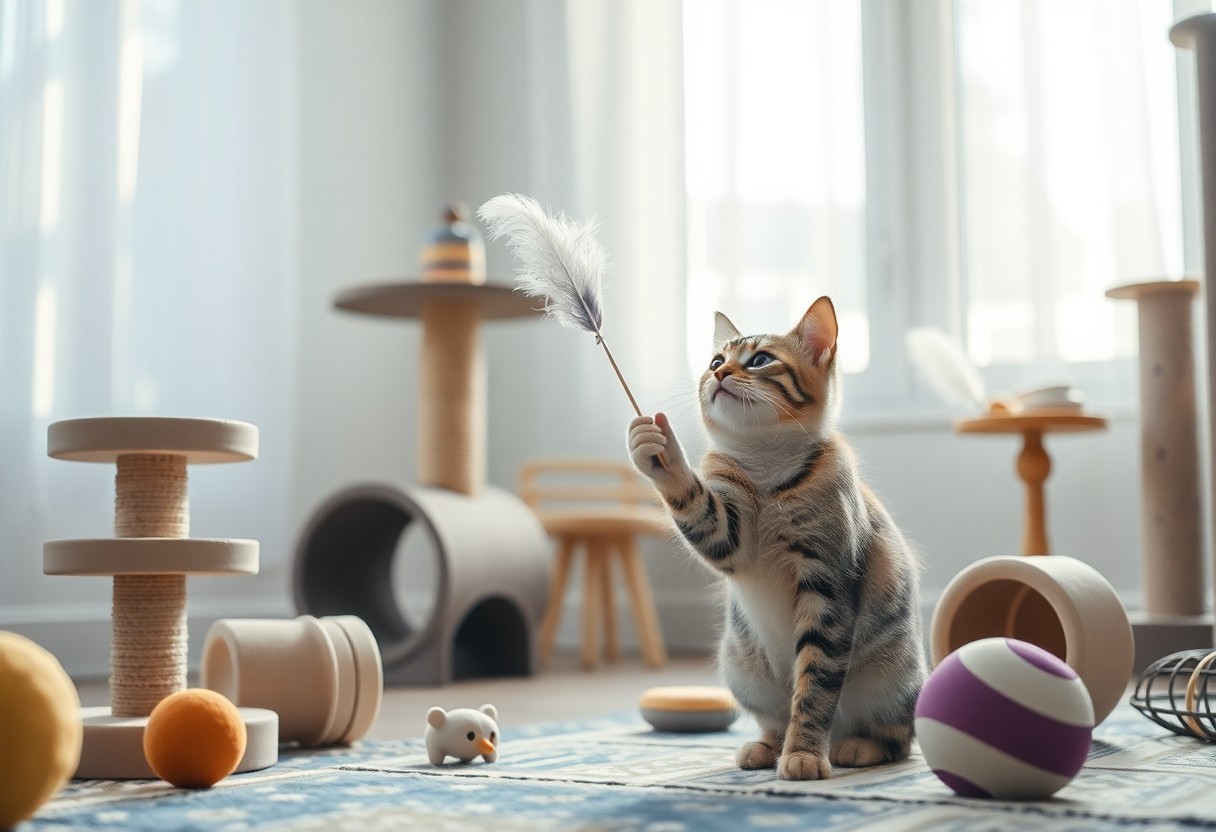
Structured Playtime: Tips and Techniques
Unlike many pets, your cat needs structured playtime to tap into their playful nature. Here are some tips to enhance their play experience:
- Set a regular play schedule.
- Use a variety of toys to maintain interest.
- Incorporate interactive games that require your involvement.
- Short play sessions can prevent fatigue and keep your cat engaged.
- Observe your cat’s reactions to find the most enjoyable activities.
Thou will find that a structured approach can lead to a more active and happy feline.
Scheduling Play Sessions
Playtime is imperative for your cat’s mental and physical wellbeing. Schedule at least two short sessions a day, ranging from 10 to 20 minutes. By establishing a routine, your cat will look forward to these interactions, which *strengthen* your bond and keep them engaged. You can adjust the schedule based on their energy levels for a personalized approach to their playtime.
Engaging Games for Cats
Beside toys, there are countless games you can play to keep your cat entertained and mentally stimulated. Interactive toys, laser pointers, and feather wands can stimulate their hunting instincts, encouraging them to physically engage with their surroundings. Regularly introducing new elements such as cardboard boxes or paper bags can also keep the environment fresh and exciting.
Sessions of play should involve a mix of both individual and interactive games to maximize your cat’s engagement. Utilize feather wands to mimic prey movement or laser pointers for an exhilarating chase around the room. It’s imperative to ensure the play area is safe and free from harmful objects. The goal is to promote healthy activity while avoiding any accidents. Also, observe your cat’s behavior: slow or low-energy responses may signal it’s time to swap out toys or incorporate new games. Through these methods, you can provide stimulating play sessions that allow your cat to express their natural instincts effectively.
Observing and Adapting to Your Cat’s Preferences
All cats have unique personalities and play styles, so observing their behaviors during playtime is imperative in tailoring activities that engage and entertain them. By taking the time to watch what captivates your feline friend—be it chasing a feather, pouncing on a toy mouse, or batting at a laser pointer—you can provide a more fulfilling play experience that meets their specific needs.
Identifying Favorite Activities
By engaging with your cat in different play scenarios, you can identify their favorite activities. Try varying the types of toys you use or the environments in which you play. Pay attention to what excites your cat the most—are they more interested in interactive play or solitary exploration? Taking notes on their reactions can guide you in creating a personalized play routine that keeps their playful spirit alive.
Adjusting Play Strategies
With the knowledge of your cat’s preferences, it’s time to adjust your play strategies to enhance their enjoyment. Incorporating different toys or play styles not only ignites their interest but also encourages physical activity and mental stimulation. Be willing to rotate toys regularly and introduce new items that align with their preferred styles. Cats often thrive on variety, so keeping their playtime dynamic will prevent boredom and keep them engaged.
Favorite strategies include mixing up the intensity of play, as some cats prefer gentle interactions, while others enjoy a more vigorous chase. Adjust the length and frequency of play sessions to match your cat’s energy level and attention span. Additionally, consider having interactive toys that encourage independent play when you’re not around. This balance will keep your cat’s instincts sharp and contribute to a happy, healthy lifestyle.
FAQ
Q: Why is it important to engage my cat in play?
A: Engaging your cat in play is vital for their physical and mental well-being. Playtime helps prevent boredom, reduces stress, and can diminish behavioral issues such as scratching or aggression. Regular play also aids in maintaining a healthy weight and stimulates natural hunting instincts, which can enrich their lives significantly.
Q: What types of indoor toys can I use to encourage my cat to play?
A: There are a variety of indoor toys that can entice your cat to play. Popular options include feather wands, laser pointers, toy mice, and interactive puzzle toys that dispense treats. Toys that mimic the movement of prey, such as remote-controlled mice or balls that roll unpredictably, can be particularly engaging for your cat.
Q: How can I create a stimulating environment for my cat indoors?
A: You can create a stimulating environment by incorporating various elements such as climbing trees, scratching posts, and cozy hideaways. Adding shelves or cat perches allows your cat to explore and gain different vantage points. Additionally, rotating toys and introducing new items periodically can keep their surroundings fresh and exciting.
Q: How often should I play with my cat for optimal engagement?
A: It is recommended to play with your cat for at least 15-30 minutes each day, split into multiple short sessions. Cats have varying energy levels and may prefer different playtimes throughout the day, so observing their behavior can help identify peak activity times when they are most eager to engage.
Q: Can social interactions with humans or other pets enhance my cat’s playfulness?
A: Yes, social interactions can greatly enhance a cat’s playfulness. Engaging in play with your cat using toys helps strengthen your bond and makes playtime more enjoyable. Additionally, if you have other pets, supervised play with them can provide new dynamics and stimulation, enriching your cat’s overall play experience.
